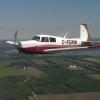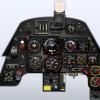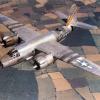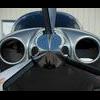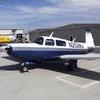Leaderboard
Popular Content
Showing content with the highest reputation on 04/17/2013 in all areas
-
If you can not land with full flaps without bouncing hard...this is an excuse to practice. Not good people, not good. Don't sell partial and or no flap landings as what to do...been there done that. Master your birds...2 points
-
Well, I have to disagree that speed is the issue. Ground speed maybe, but airspeed no. I can land my 231 at 90 in gusty crosswinds. There are typically two things that cause a bounce, and I will add a controversial third. First, the pilot fails to ease the nose up on landing and the plane hits flat or nose first. That guarantees a bounce and a porpoise. Second, and maybe a bigger factor with the later models with heavier engines, is the the pilot's failure to hold the nose back at the moment of touchdown. The common reaction is to let the yoke move forward at the moment of touchdown. That creates a bounce in which the mains hit first, and then the nose levers down and hits, and if hard enough you are in the air again and porpoising. You need to land on the mains only. If you land on the mains only, it is possible to have a small bounce, but it will always settle down quickly rather than porpoising, and it is the porpoising that creates prop strikes. If anything, I add a little extra back pressure at that moment when the mains touch to be sure the nose wheel stays off the ground. The third and controversial cause of bounces is the POH and flawed teaching. Unless you are doing a calm wind landing or a short field landing, there is no good reason to do as we are taught and use full flaps. In my aircraft, it makes the plane way too light on its feet and any excuse to go back in the air and it will do just that. I land with takeoff (half) flaps most of the time, in calm or short field conditions with full flaps, and in gusty crosswind conditions no flaps. Traditionalists go ahead and rag on me all you want, it is the way to land my aircraft. My perspective is perhaps part of the reason for my feelings on this. I live in the midwest where we are nearly always landing in gusty crosswind or headwind conditions. Calm or steady wind landings are not the norm. I would say 10% of the time I land no flaps in strong winds, 10% full flaps for a short field or calm winds, and the other 80% takeoff flaps and 85 knots short final, with the airspeed decaying to about 75 at the numbers. It is possible to save a bounced landing. Add a small amount of power and keep the nose up, then let the aircraft settle back down on the mains only. It should go without saying that you need to insure that you have sufficient runway to do this, but a Mooney when handled properly will land in a surprisingly small length. So my diagnosis is that you are landing too flat, either on the nose or on three wheels. It is odd, but I think everyone goes through spates where they just are not seeing the landing properly. Make a little more effort to raise the nose when you are within a few feet of the runway, and if it bounces a little on the mains but you have kept the nose off the ground all will be good.2 points
-
Bob, my dipstick is a wooden paint stick which is about 1 inch wide from memory. About 1/8 of an inch thick. One has to be careful with this... imagine this situation in a Hypothetical NTSB report: The pilot used a homemade extension tool made of wood, in order to help with the tank switching in flight. The safety belts arrangement in the aircraft does not allow enough body forward movement to properly rotate the lever by hand. On the first trial in flight of this tool, the wooden stick broke about a quarter inch high from the tip while attempting switching the tank. The loose wooden part lodged under the lever, preventing further movement and IN THE OFF fuel position. While the pilot was fighting removing his safety belt in order to get better access to the valve lever, the engine quit due to fuel starvation. The pilot decided to keep flying the plane and find an appropriate emergency landing location...... Yves2 points
-
I find looking down the runway's full length and using my peripheral vision helps a lot to gauge the correct flare height. If you are accustomed to landing Pipers and Cessnas and using their visual reference, you will find that you are flaring too high. I think of landing a Mooney like Fred Flinstone with his feet hanging out below. You feel that low when in the right altitude/attitude. Are you hearing the stall warning at all? You should be at the correct speeds but if you are not hearing the stall warning, I am wondering if your airspeeds are off. When I do it right, the stall goes off just as my wheels are touching. I find that landing the Mooney has been easier than other planes as long as you keep the speed nailed.2 points
-
You say "full nose-up trim" . . . Is that what you really mean? I would take that to mean you've got the aircraft primed to leap back into the air on any bounce at all. While I'm always thinking I should dial in more nose-up than I end up with, I almost always have very close to take-off trim by the time I actually put it on the runway. There are many paths, however . . .1 point
-
1 point
-
My C lands beautifully with Takeoff flaps, but the only F I've ever landed did much better with Full flaps. The sight picture is the same, pattern speeds are the same . . . Figure on 75 mph over the numbers at gross, then slow down 5 mph for every 300 lbs below gross you are. Solo and half tanks, shoot for no more than 70 mph over the numbers. I generally pull throttle to idle somewhere on final, once I know I can glide to the runway. Took a Piper pilot to ride recently to see how well his 6'4" body fit into a Mooney, and he commented that pulling the throttle to idle [before I cleared the trees] did nothing to my glide, but in the Cherokees he flies it makes the plane settle so he waits until he's over the runway. When I visit a nearby airport [KDWU, Ashland, KY], the pattern for 28 has base leg extending over the Ohio River and turning final, with the riverbank reappearing on short final; it is not uncommon to pull the throttle while still over the water. Mooneys are great gliders, test it out with some ground clearance sometime. Also, my stall horn squalls on landing, before the wheels squeek. If I can figure out how to post a video using my Droid tablet [that the tablet won't play! Recorded using a Sony digital camera], I have a nice landing video from the base-to-final turn to all three wheels rolling.1 point
-
I have some experience with this if you want to give me a call - (617) 877-0025. My e-mail is johnabreda@yahoo.com Which model Mooney do you have?1 point
-
I cannot see enroute for a long flight these being effective but for initial taxiing and maybe save your ice for taxiing on the other side. Fly high young man fly high. I generally fly above 7k (10k to 11k preferred) for this reason. At least in the south above 7k it gets pretty comfortable OAT in the 50s to 60s. I thought about building one myself but too many other projects and I'd rather spend the time flying.1 point
-
Boy I think we're splicing hairs here. Both are fine and neither are going to make a engine last longer or shorter. Champion may have the more reconignized name but they lost my business by not responding to the market place by not changing their design flaw with there spark plugs. Shows they choose not to continue to improve there products.1 point
-
Bob, your's looks almost the same as my fuel dip stick. I think I am going to make a new one which will be dual purpose: Tank switcher and fuel mesurer! Only one thinghy to worry about. Yves1 point
-
1 point
-
I trained in a 150 (in 1969,) did one cross country trip in a 172, joined a flying club, checked out in a Cherokee and started flying a Mooney @ 2 weeks after private check ride and 53 hours TT. Never looked back,1 point
-
We routinely fly the O1 X-country (200nm) at 11,500' VFR or 12,000' IFR. Staying under O2 levels. Mostly personal travel. So no FIKI either. Climbs quickly to top nearby Class B air space... It's not quite turbo, but the extra pair of cylinders helps a lot. We had 1800 hours out of the cylinders without requiring replacement. Best regards, -a-1 point
-
Measure with a micrometer, mark with chalk, cut with an axe . . . :-) The nice thing about this tool is that you can make it to fit you, your plane and your storage needs. If your first try isn't optimal, make another one that's a better fit.1 point
-
When I bought my Encore it had 400 hours on it. I flew it by the book without sophisticated engine monitoring and had to get it topped at about 1,000 hours. I sold it shortly afterwards. With the Acclaim I have much better engine monitoring and I use that to run it very conservatively at 50LOP whenever possible. There I'm seeing CHT's in the high 200's. If I don't make it to TBO or at least pretty close running it like that I'd be surprised. But we shall see....1 point
-
You do have it on your list! I missed them on the first read. Yes, I want those airbags - everybody write to the amsafe guys and tell them you want airbags - at least do it for me so I can get them... We can agree to disagree that the AOA with voice annunciator would have helped this guy. For me, sitting at my desk I will tell you that I will not try to turn back if it ever comes to that. So there is my decision. But if it ever does happen to me, in the heat of he moment - I hope and plan to follow my own advise made now in the comfort of my desk. Now if I ever get sort of loopy for just that heat of the moment, and fixate on doing it anyway, maybe a voice annunciator reminding me of the imminent stall would be just enough to wake me out of delerious optimism that I could turn back? All I am saying is that there are alot of guys trying to turn back and I am not ready to simply call them stupid. I am also willing to look deep inside myself and consider if there might be a little bit of stupid inside of me willing to try and come out at just those moments. Its the only way to try and beat it. And so I still think a voice annunciator is a safety item for just such a moment.1 point
-
As far as I can tell, the c is one of the best values in aviation. I love mine.1 point
-
Here's the one I just made and it works great. I used 3/4 in PVC. I'll try another with 1/2 but it may not go over the knob. The straight piece is 10 in long because that the longest I could get with my band saw. But it is just right. The slot is 1/4 in wide. I used a band saw but you could use a hack saw and do just as well. I then got a 3/4 in T and cemented it on IN LINE WITH THE SLOT. I will keep it in the pocket with my checklist next to my left knee. BILL1 point
-
Sounds like you're having a good time! Welcome to the club, we know the best Mooney model. Try a little slower on final--I generally aim to cross the numbers at 75 mph at gross, and 5 mph slower for eavery 300 lbs lighter. Gets me into my 3000' home field easily. Less flap whenever the wind is strong, Takeoff position works well too.1 point
-
When I am preflighting the airplane I leave the key in the lock to the baggage door so I will remember to lock it (mine has an emergency release inside the airplane). Only problem I have had is the couple of times I got into the airplane with the key hanging in the baggage door......grumble, grumble....climb back out......lock the door.........but no harm done. As for the HSI, I also point it to the intended departure runway before I taxi but I also set the heading bug to the heading I am cleared to after take off. So if I am departing runway 27 the yellow HSI pointer is set to 270. If I am instructed to fly heading 360 after departure I will put the heading bug there before I take the active. On arrival I will set up an instrument approach for landing runway on my 430 (whether its a ILS, localizer, GPS, etc.) even in visual conditions. I imagine I have lots of others......1 point
-
Thanks for the feedback on gear retraction on takeoff. I decided to delay gear retraction until about 100' and 75-80 knots. Below 100', if the engine quits, just land. My home field is >8000. Above 100', you have time to react, get the nose down and optionally extend the gear.1 point
-
1 point
-
Hi. Yes, I just bought my '67F and it came with an extention. Im flying tmor (king air) but will try to remember to go grab it out of the mooney and get dimensions and post it for all. But....Its pretty straight forward. just a 12'' piece of pvc with a T at one end and a notch cut out of the other that fits over the selector handle. Todd1 point


